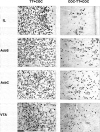COT-TT vaccine attenuates cocaine-seeking and cocaine-conditioned place preference in rats
- PMID: 38228468
- PMCID: PMC10793666
- DOI: 10.1080/21645515.2023.2299068
COT-TT vaccine attenuates cocaine-seeking and cocaine-conditioned place preference in rats
Abstract
Vaccination active, promising alternative immunological strategy to treat of CUD. Various models of cocaine vaccines have been evaluated in animals and humans with relative success. In this sense, it is necessary to improve or optimize the cocaine vaccines already evaluated. Our laboratory previously reported the efficacy of the tetanus toxoid-conjugated morphine vaccine (M6-TT). The M6-TT vaccine can generate high titers of antibodies and reduce heroin-induced behavioral effects in rodents. So, it would be plausible to assume that if we modify the M6-TT vaccine by changing the hapten and maintaining the rest of the structural elements of the vaccine, we will maintain the properties of the M6-TT vaccine (high antibody titers). The objective of this study was to determine whether the antibodies generated by a tetanus toxoid-conjugated cocaine vaccine (COC-TT) can recognize and capture cocaine and decrease the cocaine-induced reinforcing effects. Male Wistar rats were immunized with the COC-TT. A solid-phase antibody-capture ELISA was used to monitor antibody titer responses after each booster dose in vaccinated animals. The study used cocaine self-administration and place-preference testing to evaluate the cocaine-reinforcing effects. The COC-TT vaccine could generate high levels of anti-cocaine antibodies. The antibodies reduced the cocaine self-administration and cocaine place preference. In addition, they decreased the cocaine-induced Fos protein expression. These findings suggest that the COC-TT vaccine generates a robust immunogenic response capable of reducing the reinforcing effects of cocaine, which supports its possible future use in clinical trials in patients with CUD.
Keywords: Active vaccination; COC-TT vaccine; antibodies; cocaine; cocaine place preference; cocaine self-administration.
Conflict of interest statement
No potential conflict of interest was reported by the author(s).
Figures




Similar articles
-
NIC6-TT Vaccine Reduces Nicotine-Seeking Behavior and Expression of Nicotine-Induced Locomotor Sensitization in Rats.Brain Sci. 2025 Mar 31;15(4):364. doi: 10.3390/brainsci15040364. Brain Sci. 2025. PMID: 40309854 Free PMC article.
-
COT-TT vaccine attenuates induction and expression of cocaine-induced behavioral sensitization in rats: a dose-response study.Front Psychiatry. 2025 Jun 3;16:1548585. doi: 10.3389/fpsyt.2025.1548585. eCollection 2025. Front Psychiatry. 2025. PMID: 40530054 Free PMC article.
-
The morphine/heroin vaccine decreased the heroin-induced antinociceptive and reinforcing effects in three inbred strains mouse.Int Immunopharmacol. 2021 Sep;98:107887. doi: 10.1016/j.intimp.2021.107887. Epub 2021 Jun 26. Int Immunopharmacol. 2021. PMID: 34186279
-
Meningococcal groups C and Y and haemophilus B tetanus toxoid conjugate vaccine (HibMenCY-TT; MenHibrix(®)): a review.Drugs. 2013 May;73(7):703-13. doi: 10.1007/s40265-013-0048-9. Drugs. 2013. PMID: 23649970 Review.
-
Persistence of bactericidal antibodies following primary and booster MenACWY-TT vaccination of toddlers: A review of clinical studies.Vaccine. 2020 Jun 2;38(27):4236-4245. doi: 10.1016/j.vaccine.2020.02.048. Epub 2020 May 7. Vaccine. 2020. PMID: 32389497 Review.
Cited by
-
NIC6-TT Vaccine Reduces Nicotine-Seeking Behavior and Expression of Nicotine-Induced Locomotor Sensitization in Rats.Brain Sci. 2025 Mar 31;15(4):364. doi: 10.3390/brainsci15040364. Brain Sci. 2025. PMID: 40309854 Free PMC article.
-
COT-TT vaccine attenuates induction and expression of cocaine-induced behavioral sensitization in rats: a dose-response study.Front Psychiatry. 2025 Jun 3;16:1548585. doi: 10.3389/fpsyt.2025.1548585. eCollection 2025. Front Psychiatry. 2025. PMID: 40530054 Free PMC article.
References
Publication types
MeSH terms
Substances
LinkOut - more resources
Full Text Sources
Other Literature Sources
Miscellaneous
